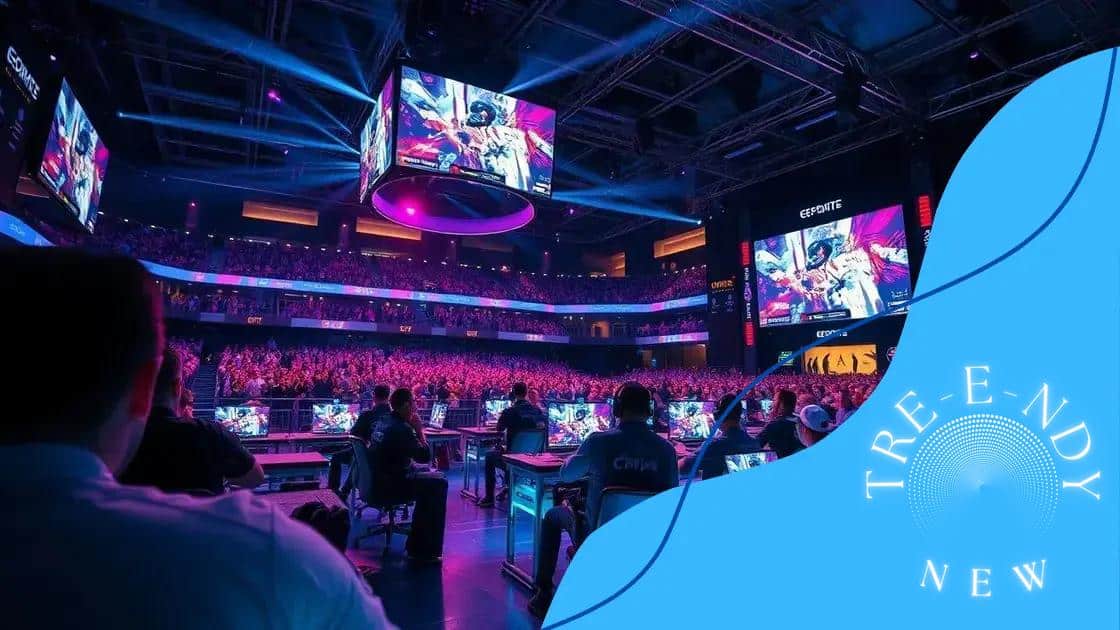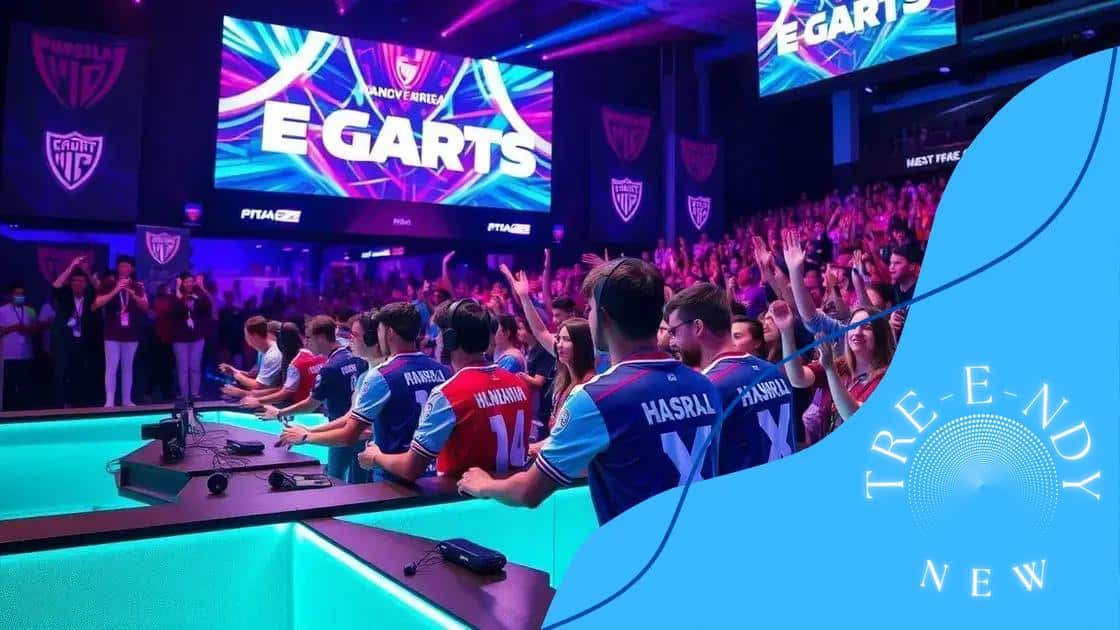How e-sports are influencing mainstream media content

E-sports are significantly influencing mainstream media content by integrating interactive viewing experiences, enhancing audience engagement through social media, and creating collaborative opportunities that foster deeper connections between fans, players, and brands.
How e-sports are influencing mainstream media content is a fascinating shift that’s reshaping the entertainment landscape. Have you noticed how gaming tournaments are getting airtime on major networks? This intersection is worth exploring.
The rise of e-sports in popular culture
The rise of e-sports in popular culture has been remarkable, drawing millions of fans worldwide. This phenomenon is not just about gaming; it has transformed into a mainstream entertainment platform. More people are tuning in to watch professional gamers compete, just as they would with traditional sports.
Events like The International and League of Legends World Championship fill stadiums and screens, attracting numerous viewers. As games become more sophisticated, their narratives pull in audiences, making e-sports events exciting to watch.
Why E-sports Matter
Understanding the influence of e-sports on society can be crucial for shaping future media. Here are some reasons they matter:
- Engagement: E-sports create communities where fans connect and share experiences.
- Sponsorship Deals: Major brands invest significantly, which elevates the visibility of e-sports globally.
- Mainstream Recognition: Traditional media networks are increasingly covering e-sports, recognizing its large audience.
E-sports also reflect shifts in how younger generations consume content. This shift is visible through various media platforms, where gaming culture merges with entertainment. For instance, streamers often collaborate with celebrities, increasing their reach and impact.
The Role of Social Media
Platforms like Twitch and YouTube play a big part in the e-sports rise. They serve as a primary venue for gamers to showcase their skills and interact with fans. This accessibility allows anyone to participate in gaming culture, fostering a sense of belonging.
Moreover, the interaction on these platforms encourages live discussions and instant feedback, enhancing the viewer’s experience. Social media allows for immediate sharing of highlights and moments, which keeps the excitement alive. This blend of gaming and social networking is unique and fosters a strong sense of community.
In recent years, e-sports have also found their way into educational settings. Schools and colleges are introducing e-sports teams, which promote teamwork and strategic thinking among students. This academic recognition illustrates how deeply embedded gaming has become in contemporary culture.
The influence of e-sports on popular culture is undeniable and continues to grow. As more viewers appreciate competitive gaming, it shapes the entertainment landscape in real-time. From building communities to engaging with fans, e-sports are not just a passing trend—they’re here to stay.
How e-sports narratives engage audiences
How e-sports narratives engage audiences is a critical aspect of their success. These stories create excitement, making viewers feel connected to the players and teams. The narratives often build around rivalry and personal journeys, making competitions more than just games.
Moreover, every match tells a story that unfolds in real time. Fans eagerly follow the players’ paths, celebrating victories and learning from defeats. This engagement turns casual viewers into loyal fans.
Compelling Storylines
E-sports create compelling storylines that resonate with audiences. Here are some key elements that enhance engagement:
- Character Development: Players often develop iconic personas that fans relate to and root for.
- Team Dynamics: Team rivalries and group chemistry add depth to the competition.
- Underdog Stories: Viewers love to see lesser-known players rise to the occasion and defy expectations.
These stories are often amplified through social media platforms, where fans share highlights, memes, and discussions. This leads to a vibrant community that thrives on shared experiences and emotional connections, driving even more interest in e-sports.
Interactive Experiences
Another way e-sports engage audiences is through interactive experiences. Viewers can participate via live chats, polls, and voting during tournaments. This interaction fosters a sense of involvement, making fans feel like they are part of the action.
Furthermore, platforms like Twitch allow fans to interact directly with their favorite gamers. This connection reinforces loyalty and enhances the overall experience, making e-sports not just about watching but participating. By bridging the gap between players and viewers, the narratives become even more immersive.
The capacity of e-sports to engage through rich narratives is critical for its growing popularity. As these narratives continue to evolve, they keep audiences invested in the journey of players and teams alike.
The impact of e-sports sponsorships on media

The impact of e-sports sponsorships on media is significant as it shapes the future of both industries. Companies are realizing the potential of e-sports to reach younger audiences that traditional media often misses. This new wave of sponsorships not only benefits e-sports teams but also the brands that choose to partner with them.
By investing in e-sports, brands gain exposure to a dedicated fan base. The immersive nature of e-sports means that sponsors can engage viewers more directly than traditional advertisements. This creates meaningful connections between players and fans, often leading to increased loyalty to both the game and the brand.
Types of Sponsorships
Different types of sponsorships play a role in the growing e-sports industry:
- Title Sponsorships: Brands that sponsor major events often gain extensive publicity and recognition.
- Team Sponsorships: Companies back specific teams, showcasing their logos on jerseys and in streams.
- In-game Advertisements: Brands can place their products within popular games, creating subtle but effective marketing.
These strategies not only elevate e-sports events but also enhance brand visibility. Companies understand that their placement in e-sports yields high engagement rates, as fans enjoy seeing their favorite teams supported by reputable brands.
Shifts in Media Coverage
As e-sports gain traction, the media coverage surrounding them has evolved. Traditional sports networks are increasingly airing e-sports events, recognizing their value to a younger demographic. This shift allows for greater visibility for sponsors and teams alike.
Furthermore, e-sports coverage often features discussions and analysis, similar to what fans see in traditional sports. This increase in professional coverage legitimizes e-sports in the eyes of the public, leading to more investment and higher quality broadcasts.
Overall, the impact of e-sports sponsorships on media is profound. As brands continue to invest, they not only support the growth of e-sports but also adapt their marketing strategies to meet changing consumer behaviors.
Comparing e-sports coverage with traditional sports
Comparing e-sports coverage with traditional sports reveals significant differences and similarities that shape how audiences engage with these two forms of entertainment. While both involve competitive play, their presentation and audience interaction vary greatly.
In traditional sports, commentary often focuses on player statistics, gameplay strategy, and team dynamics. This analysis takes place during television broadcasts and relay networks. E-sports coverage, on the other hand, brings a more interactive approach through platforms like Twitch. Here, fans can engage directly with streamers, influencing content in real-time.
Style of Presentation
The style of presentation is another area of comparison. Traditional sports rely heavily on live broadcasting, with a studio team providing commentary. In contrast, e-sports often feature player commentary during live streams, creating a personal connection with viewers. This less formal style tends to resonate well with younger audiences.
- Graphics and Visualization: E-sports often utilize dynamic graphics that enhance storytelling, while traditional sports may focus on player stats and team scores.
- Immediate Analysis: E-sports commentators provide instant analysis during gameplay, often reacting to events as they unfold.
- Viewer Participation: Fans can chat and interact with streamers, offering a more engaging experience compared to passive viewing in traditional sports.
Advertising in both areas has evolved. Traditional sports often feature commercial breaks with standard advertisements, but e-sports have embraced integrated marketing strategies. Brands can sponsor players and in-game events, allowing for seamless promotion within the context of gameplay.
Audience Engagement
Another vital difference is in audience engagement. E-sports foster a community-driven environment, where fans can participate in discussions on forums and social media. This level of interaction transforms passive viewers into active participants. Traditional sports, while still popular, generally do not offer the same instant connection between fans and players.
Overall, the comparison of e-sports coverage with traditional sports highlights evolving trends in media consumption. As e-sports continue to grow, they are reshaping how audiences experience competitive gaming and shifting traditional viewpoints on sports entertainment.
Future trends: E-sports and media collaboration
Future trends in e-sports and media collaboration promise to reshape how audiences engage with competitive gaming. As e-sports continue to grow, the merging of traditional media and digital platforms will become more pronounced.
One emerging trend is the rise of hybrid events that combine live audiences with digital streaming. These events will attract fans in arenas while broadcasting to millions online, creating a dual engagement model. This setup allows brands to reach diverse audiences, enhancing sponsorship opportunities.
Increased Content Production
As interest in e-sports rises, content production will expand significantly. Media companies will invest in creating documentaries and behind-the-scenes content about players and teams. This in-depth approach gives fans insight into the lives of their favorite gamers, increasing emotional investment.
- Player Profiles: Highlighting player backgrounds, skills, and their journey in e-sports.
- Team Dynamics: Showcasing how teams work together, including challenges and victories.
- Event Highlights: Producing recap shows of tournaments to keep fans engaged.
Moreover, new platforms for content consumption, such as virtual and augmented reality, will likely emerge. These technologies can create immersive experiences for audiences, making them feel as though they are part of the game.
Engagement through Social Media
Social media will continue to play a pivotal role in e-sports and media collaboration. Platforms like Twitter, Twitch, and Instagram enable real-time interaction between players and fans. Fans can share their experiences, which amplifies engagement.
Expect to see more partnerships between media organizations and content creators to leverage these social platforms. By working together, they can enhance the viewing experience, providing fans with exclusive content and behind-the-scenes access that can’t be found elsewhere.
Overall, the future of e-sports and media collaboration looks promising. As both industries evolve together, they will create new ways for audiences to experience competitive gaming, making it more accessible and engaging than ever before.
FAQ – Frequently Asked Questions about E-sports and Media Collaboration
How are e-sports changing the traditional media landscape?
E-sports are increasingly integrated with traditional media, creating new opportunities for engagement and sponsorship.
What role does social media play in e-sports?
Social media enhances fan interaction, allowing for real-time engagement between players and viewers, making e-sports more accessible.
What kind of content will we see more of in the future?
Expect to see more documentaries, behind-the-scenes materials, and hybrid events that combine live audiences with digital streaming.
How do brands benefit from sponsoring e-sports?
Brands gain exposure to a younger audience and can engage more effectively through integrated marketing strategies and sponsorships.





